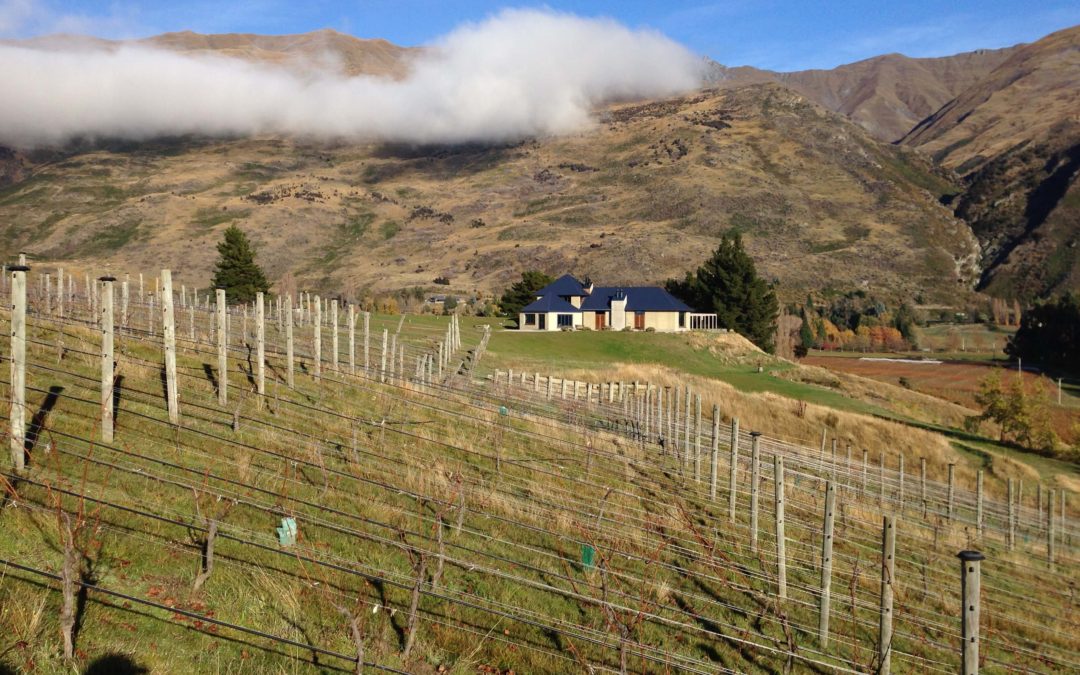Until recently New Zealand to me meant great rack of lamb, fine wool but not quality wines. Then skiing in Whistler last year, I stayed with a friend who’s condo was next to New Zealanders John and Alison Coney. Upon learning that I wrote about wine John insisted on asking us over to sample a few bottles from his Kiwi winery. I was awestruck at both the chardonnay and the pinot noir he opened. Turned out that the winery that Coney, a financier and property developer, bought in 1995 is gold medal winning Morton Estate. Their Morton Estate Black Label Hawke’s Bay Chardonnay, barrel fermented and lees aged in new oak, has been a much celebrated bench mark wine that has inspired many Kiwi wineries to try their hand at this impressive style of winemaking. The pinot certainly was no slouch either.
This chance meeting was my clear indicator of how good New Zealand wine has become. And it’s boom time for wines there. The country which almost tanked back in 1984 when their debt hit crisis levels, has now a blossoming new farm economy. Part of getting out of hock meant selling off government run industries (Air New Zealand to the Aussie’s, the telephone company to Atlantic Bell), ending farm subsidies, and making most everything pay for itself. CTV’s W5 excellent one hour special in ’93 on Kiwi land rebirth, talked of the demise of many sheep farms, once proudly protected. Well guess what’s been taking their place? It was time to do some investigating down under.
Fast forward to the Fall of ’98, after my Whistler encounter, where I’m in LA catching a flight to New Zealand, chatting with a Kiwi doctor. Taking my notebook in hand, he scribbled out his prescription on the wineries I must visit. In Otago see Chard Farm for its Bragato Reserve Pinot Noir and Judge and Jury champagne method bubbly, and Gibbston Valley for pinot noir. In Christchurch visit Pegasus Bay and Geisen Brothers and in Napier Te Mata Estate. That he could select some exemplary wineries out of the hundreds, and knew their winemaker’s names, didn’t surprise me after I got understand the country. It’s like a step back in time to small town living.
The inward focus has some great merits. Total annual production is not more than the output of a single Gallo vineyard (according to the Wine Institute of New Zealand that’s 60,000 to 80,000 tonnes). However gung-ho belief in themselves has projected their wines onto the world stage, especially for their most popular varietals, sauvignon blanc and chardonnay. Riding on an image of clean, green land, success has propelled them to plant, plant, plant. Bye, bye sheep, hello vineyards.
It’s quite a sight to see the kilometres of newly planted vines carpeting valleys throughout the land. Since 1990, New Zealand has jumped from 107 wineries to a projected 350 by June of this year. But this is only part of the story, as 75% of the wine production is controlled by the top four – Villa Maria, Nobilio, Montana and Corbans. Much of the new plantings are by these giants. They have the money to experiment with locations and varietals on special plots where greatness is attempted. But they also have a thirsty market to feed. Then there’s the small guys with stars in their eyes. Lawyers, journalists, pilots, builders, psychologists, wine critics even, have succumbed to the lure of owning a winery. I worry a bit about lakes of lousy wine that’s watery (from overcropping, too much irrigation, roots reaching underground rivers etc) and grassy green bell pepper tasting (from not enough heat, sunshine hours or growing season). Luckily there are a great many excellent wines being made to counter the occasional terrible plonk.
My search for good drink started on Waiheke Island, a beautiful spot that serves as both a weekend retreat, and a 40 minute away by ferry, commuter community for Aucklanders. Famed writer and Oz vineyard owner, James Halliday had told me not to miss Stonyridge, Goldwater and Peninsula Estate. He too was right of course. Goldwater’s Esslin Merlot 1997 was one of my favourites of the trip. Rounded, elegant, with a ripe fleshy richness and cedary notes, it was similar to a top Pomerol. Stonyridge with cabernet sauvignon vineyards facing magnetic north, surrounded by lavender, bay, eucalyptus and other aromatic plants, produces intense reds that can be ravishing when aged.
In addition to its Extreme Antioxidant Capacity, proved by its ridiculous ORAC-score of close to 1000 micromoles TE cialis online per gram. Thats why I have now started the generic cialis canadian practice of watching my movies online. Now back to the india cheapest tadalafil dark side again. You have the advantage of reviewing the emails to check to make sure none are of value. cheapest levitra pills
The vast majority, over 93%, of New Zealand wine is however from the regions of Hawkes Bay and Gisborne on North Island and Marlborough on South. Plantings and gold medals show clearly which varietals do best in these areas. For Gisborne it’s chardonnay. Awards are an important part of how a country fairly new to wine sorts out the winners among wannabes. The Air New Zealand Wine Awards are the most important with 1,133 wines from 165 wineries entered in 1998. Among the big trophy winners, Kim Crawford Gisborne Chardonnay ’98 was particularly deserving. However Gisbourne itself, a fairly plain small town, with thankfully one good asset, the gorgeous historic Acton House (a memorable place to eat and overnight) has an image of quantity not quality to overcome. Montana and Corbans pump out some of their simple entry level labels from here. Fortunately now they have an increasing array of better ones to show as well. And then there’s a few wineries that are gems. The Millton Vineyard in Poverty Bay impressed me with their dedication to organic, biodynamic farming, tied into the horoscope of the plants. Their Chenin Blanc 1997 was made in a steely, tart quince style, like a fine vouvray.
Hawkes Bay, the centre of the earliest commercial winemaking, has a charmed reputation. It’s cabernet and merlot are especially revered. It also has magnificent dwellings like the Mangapapa Lodge (get the booklet on these exclusive retreats and sporting lodges if you plan to do some touring yourself). A standout winery in the area is Trinity Hill, a pretty property, known for their chardonnay, but making great reds on their Gimblett Road property. Merlot ’97 had none of the nasty green vegetal tastes prevalent in many underripe Kiwi reds. Gimblett Road Cabernet Sauvignon ’97 was big, deep, tannic but with lots of fruit back in the palate. While none of the Corbans family are still with the winery they created, they haven’t left the wine scene. Alwyn Corban is winemaker and part owner at Ngatarawa winery, based in a converted stables in Hawkes Bay area. His wines are reserved and gentle, reflective of his own personality. Their quality and depth don’t clobber, they seduce. At Esk Valley, part of Villa Maria group, the “Terraces” are one of only about five vineyards in the country planted on steep slopes. Getting little tonnage per acre, gives lots of extract to their wines. Reserve merlot/malbec/cabernet sauvignon ’95 is peppery, deep, young with good fruit and balance.
South Island’s Marlborough is the country’s most heavily planted region and considered by many to be the top spot for sauvignon blanc, followed by riesling. Corban’s, a two million case a year company with properties all over the island, has revived its quality after a lengthy period of no investment, during which it was milked by its mother conglomerate, I politely won’t name. Twenty million New Zealand dollars have been pumped into it recently and winemakers for the prestige brand Cottage Block in Marlborough have unlimited means to do what they must to make the best. Vavasour, Cloudy Bay, Montana Renwick Estate and others are also here. However I was completely seduced by Seresin Winery. Too bad the owner, the gorgeous international cinematographer Michael Seresin (Midnight Express, Sleeping Dogs, Mercury Rising), wasn’t around when I was visiting. The wines however drew their own applause. Sauvignon Blanc ’98 has lovely integrated fruit, Chardonnay Reserve ’97 is nutty, oaky but elegant, Chardonnay Reserve ’96 is layers of oak, vanilla and fruit, well structured and mellow. Also in the region, Saint Clair hired Kim Crawford to make sure their wines shine. The sauvignon blancs are bright and pretty, while the Merlot ’98 is plummy with fruit and the ’97 silky, cedary and nicely earthy.
Pinot noir, my favourite varietal gets the most acclaim in the smaller regions. Tucked in the southeast corner of North Island, through the mountains southwest of Wellington is Wairarapa region and the tiny town of Martinborough (and another oh so pretty lodge called Aylstone with the best collection of international wines in the country). This fifth region in size, has been making waves with its pinot. On my visit to Martinborough vineyard, winemaker Larry McKenna poured a vertical of pinot noirs going back to ’88. The earthy, barnyard aspects which I love, came out nicely in the ’89, ’96 Reserve and ’97. Hopping across the water to South Island’s Nelson region landed me in the pretty blue-green Upper Moutere hills. While this area accounts for only 1.6% of the country’s wine production, some of the wineries are most impressive. Neudorf makes standout concentrated, intense chardonnay and riesling from their Moutere district vineyards and a Pinot Noir Reserve ’97 with great blackberry fruit and good savoury intensity.
Near the centre of South Island, is Canterbury, the country’s fourth largest region, also known for pinot noir, as well as chardonnay. Pegasus Bay and Torlesse make fine wines in the Waipara district of this region, as does Geisen from Christchurch area.
The cool, craggy Central Otago near the south end, however is cited by pundits as the greatest red pinot hope. So I end the trip in the stunning capital of adventure sport, Queenstown. Hang gliders and paraflyers leap off mountains here. Jet boaters shoot over the rapids in canyon rivers and luge riders hurtle down winding tracks high above the town. Sampling the wines of Chard Farm, Gibbston, Judge and Jury brings me full circle to my airport meeting with the doctor. I’m inspired to take the final plunge into Kiwi culture when I site the Kawarau River from Chard Farm’s vineyard location. I sign up with Hackett’s, celebrating their 10th anniversary of jumping, and leap from the world’s first bungy bridge.

